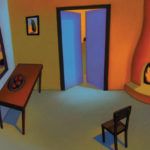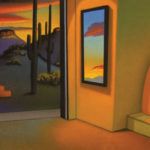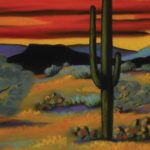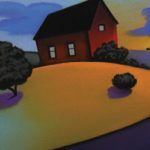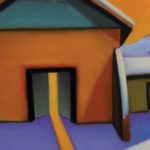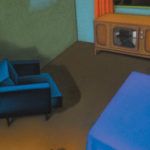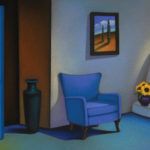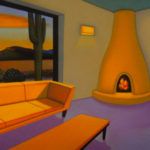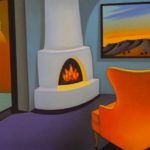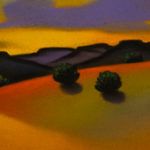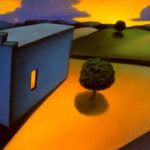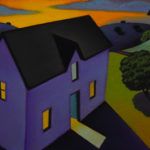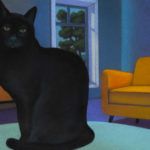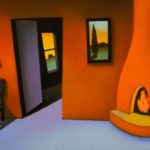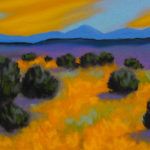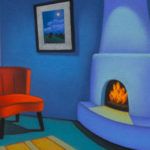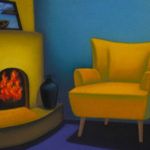Victoria Taylor-Gore’s pastel paintings offer entry into magical realms between day and night
By Norman Kolpas
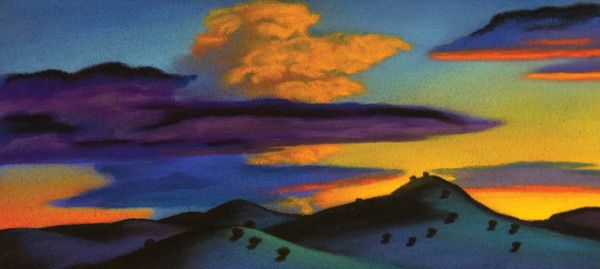
Victoria Taylor-Gore, Evening Begins, pastel, 7 x 15.
This story was featured in the July 2020 issue of Southwest Art magazine. Get the Southwest Art July 2020 print issue or digital download now–then subscribe to Southwest Art and never miss another story.
“THE TWILIGHT IS the crack between the worlds,” wrote cultural anthropologist Carlos Castaneda in his 1968 bestseller The Teachings of Don Juan. “It is the door to the unknown.”
Perhaps no more apt description could sum up the enthralling pastel paintings of Victoria Taylor-Gore. The artist shares that quote on her website, offering a hint of explanation for the mysterious and irresistibly beckoning, crepuscular yet vividly colored scenes she creates from pure imagination. In barely furnished but firelit rooms, doors and windows gape to reveal darkening skies still ablaze from the setting sun. Saguaros and sagebrush take on near-human character in the dying light of landscapes devoid of people. Southwestern homes and churches stylized to the point of near abstraction stream bright light into the darkness from their open windows and doors.
- Victoria Taylor-Gore, And so it Goes, pastel, 10 x 14.
- Victoria Taylor-Gore, Awakening, pastel, 8 x 18.
- Victoria Taylor-Gore, Desert Glow, pastel, 6 x 12.
“The atmosphere between day and night is magical,” continues the artist in her own words, before going on to cite another major influence on her thinking: the writings of the early 20th-century psychoanalyst Carl Jung. “Day,” says Taylor-Gore, “is a symbol of the waking conscious, and the night is a symbol for our collective unconscious. I love that transition between the day and the night. The colors in the sky get very intense, and they’re a little muted on the land, except where the orange light strikes a bush or a tree in a beautiful golden-orange light. I see my paintings as little worlds, places where the viewer and I can go to escape. And I think color is the magic that helps make it happen.”
THINKING BACK to her childhood memories of Colorado, where she was born, and Canyon, TX, where her family moved when she was in her teens, Taylor-Gore doesn’t find many signs of a passion for color. “When I was 10, 11, or 12, I started drawing with a plain pencil, copying Mad magazine and comic books and record-album covers. I drew a lot of pencil portraits of David Crosby,” she recalls. Though she enthusiastically participated in the excellent art program at Canyon High School, her academic goal at the time was to “go into some kind of environmental science,” and she maintained a high grade point average in the hopes of getting into a top college.
- Victoria Taylor-Gore, Evening Road, pastel, 5 x 12.
- Victoria Taylor-Gore, Late Snow, pastel, 5 x 12.
- Victoria Taylor-Gore, The Black Shoe, pastel, 14 x 10.
But suddenly, just after her junior year, her mother died of a heart attack. “It was really gut-wrenching,” she recalls. “I decided that life was too short, so I was going to do what I wanted to do instead of what I thought I should do. To heck with it all! I was going to be an artist.”
Back at school for senior year, she began concentrating on art and won “a little scholarship” to West Texas State University in Canyon (which has since become part of the Texas A&M system). She started out as a graphic-design major but then got a chance to meet five working artists who were applying to teach at the school; she realized that “you could make a living at art” and switched her major to fine art.
Early on in her undergraduate studies, Taylor fell in love with color and, more specifically, with how vibrantly she could express the power of color through the medium of pastels. “My teachers were very supportive,” she says. “When someone would ask me why I wasn’t painting instead, I would say that I was painting, with colored dust. Once in a while I would do a painting in oils to prove I could paint, but then I always gravitated back to pastels.”
During those years, she fell in love with and married fellow art student Kenneth Gore. The two of them applied to continue their studies in graduate school. Both won full scholarships to the outstanding master’s program at the University of California at Santa Barbara, from which they graduated in 1985.
- Victoria Taylor-Gore, White Kiva, pastel, 10 x 19.
- Victoria Taylor-Gore, Desert Light, pastel, 8 x 15.
- Victoria Taylor-Gore, Escape, pastel, 11 x 18.
Taylor-Gore considers her years at UCSB seminal to her subsequent career and artistic success. “For me, it was two years away from the hectic pace of the world, two years during which I developed my work and found my style. That’s huge,” she says. Among the most formative experiences, she notes, was her job as a teaching assistant in color theory to internationally respected postmodern painter Ciel Bergman, who passed away in 2017. “She was my first female fine-art teacher, a strong, powerful, very direct and honest woman who was very supportive of me trying different things and really influenced the way I used color.”
As for her stylistic approach, she says, that came one day after she had been “stewing over a lot of works” by artists she admired. There was Paul Gauguin’s experimental use of color, René Magritte’s “theatrical feeling and wit,” the surreal architectural scenes and saturated early-evening tones of Italian metaphysical painter Giorgio de Chirico, Georgia O’Keeffe’s smooth tonal blends and simplified forms, and more. Thus inspired, she says, “I just began attacking the paper and did this interior, looking down on a room where you could see all four walls coming up in perspective, and there were dolphins swimming through the room and holes in the floor and a moat between the room and the walls, with stars underneath. After that, I drew differently in this warped 3-D perspective.” Her final year in Santa Barbara, a gallery in Los Angeles gave Taylor-Gore her first show.
- Victoria Taylor-Gore, Fireside, pastel, 13 x 17.
- Victoria Taylor-Gore, Hill Spirits, pastel, 5 x 15.
- Victoria Taylor-Gore, Light of the Sun, pastel, 9 x 19.
She continued creating such scenes following graduation and, while in the process of a divorce, a move home to Texas, which she left again for six months in L.A. before making the Lone Star State her home for good. Gradually, overtly surreal imagery like dolphins, moats, and starry holes in the floor gave way to more real-world elements inspired by the landscapes and architecture of New Mexico, which she began visiting regularly, and the landscape of the Texas Panhandle. She was hired as an art teacher at Amarillo College two decades ago and progressed to become department chair and then dean before finally leaving in January 2019. “I was losing myself in administration,” she says with a chuckle.
NOW, AT AGE 60, Taylor-Gore relishes devoting her full working time once again to her art rather than feeling like a part-time freelancer. Her recent works show all of the vigor, inquisitiveness, originality, and power that have characterized her work since the early days of her professional career.
Take her painting THE BLACK SHOE, which gazes down into an anonymous motel room as night falls and the full moon rises above distant mountains outside the window. The setting feels cozy, inviting. Yet the presence of the single high-heeled shoe, the steep angle from which the room is shown, and a shadowy fedora-wearing man visible on the television screen all add just a hint of uncertainty that invites the viewer to speculate. “I just love film noir,” says the artist, “so it was fun putting in a little mystery.”
- Victoria Taylor-Gore, Road to Sunset, pastel, 5 x 12.
- Victoria Taylor-Gore, Shadow Cat, pastel, 10 x 19.
- Victoria Taylor-Gore, Saving Grace, pastel, 10 x 14.
The black paper on which many pastel artists typically draw further underscores that slight sense of foreboding. But Taylor-Gore’s most recent works show the results of a new challenge she has given herself: creating her scenes on thick sheets of white watercolor paper. She begins that process by first applying to the paper a thin, transparent, burnt-orange or mustard-hued stain of watercolor or gouache, which lends an overall warmth to the final piece. Then, working from a simple ballpoint-pen sketch on a lined legal pad she typically does to work out her composition, she’ll use a pencil to transfer it to the paper in more meticulous detail. (When she uses black paper, the pencil has white or light-green lead.) Finally come the pastels, applied in pencil or block form depending on the level of detail in the area she’s painting. “I have to work on a table, and there’s a lot of precision involved so I don’t smudge it with my hand,” she adds.
What can result is a painting like AWAKENING, depicting a contemporary desert home with a living-room wall slid open to regard the sunset in all its splendor—a view amplified by a mirror that also reflects the sky. “I liked the surreal idea of having two sunsets in one painting,” says Taylor-Gore. “It’s sort of a world within a world.”
When her subject is the outdoors—as in the recent DESERT GLOW, set in the saguaro-studded landscape outside of Tucson—Taylor-Gore’s works can seem just as appealingly surreal. Or consider the blocky residential forms in EVENING ROAD, looking like so many Monopoly hotels come to life and casting eerie light from their windows and doors. “I just enjoy doing the little houses,” she says. “While the interiors often involve reference in some way, for [the houses], I will often just look at a sunset, look at some clouds, get some ideas, and take off from my imagination.”
- Victoria Taylor-Gore, Sunset Mesa, pastel, 6 x 10.
- Victoria Taylor-Gore, Two Moons, pastel, 8 x 10.
- Victoria Taylor-Gore, Warm Corner, pastel, 9 x 10.
More often than not, what results is a work of art that possesses the power to help viewers’ imaginations take flight. And that journey can become a subtly transformative experience that even Carlos Castaneda or Carl Jung might have found magical.
representation
Alexandra Stevens Gallery of Fine Art, Santa Fe, NM; Wilder Nightingale Fine Art, Taos, NM; Jane Hamilton Fine Art, Tucson, AZ; Cerulean Gallery, Dallas and Amarillo, TX.
This story was featured in the July 2020 issue of Southwest Art magazine. Get the Southwest Art July 2020 print issue or digital download now–then subscribe to Southwest Art and never miss another story.
MORE RESOURCES FOR ART COLLECTORS & ENTHUSIASTS
• Subscribe to Southwest Art magazine
• Learn how to paint & how to draw with downloads, videos & more
• Sign up for your Southwest Art email newsletter & download a FREE ebook






